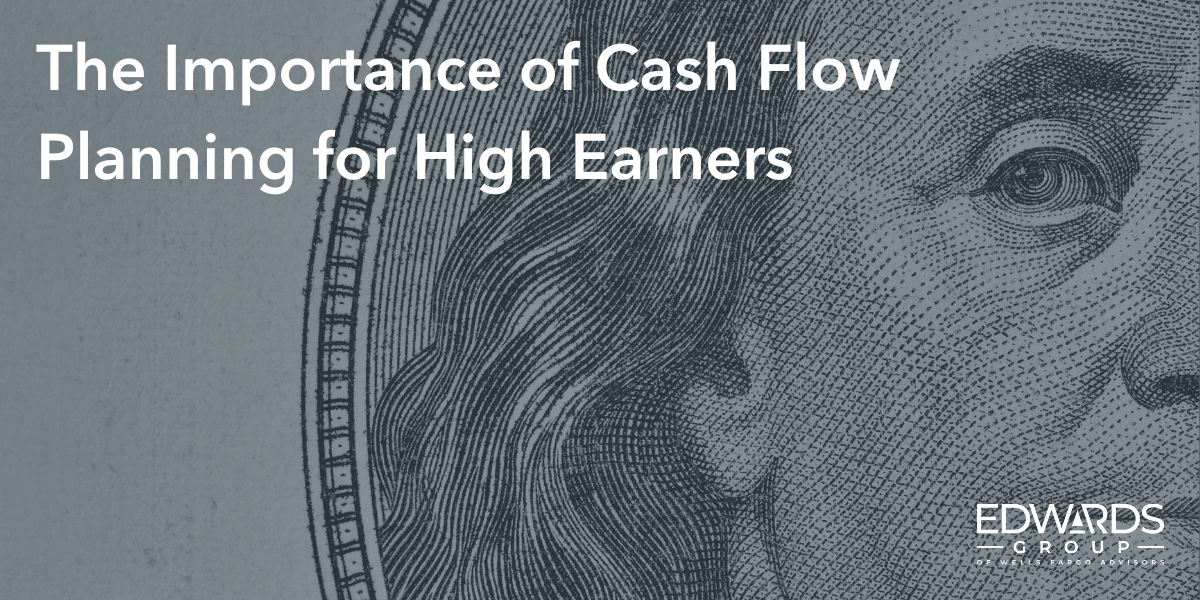The Importance of Cash Flow Planning for High Earners


You’ve already achieved a great level of financial success in your life, meaning it’s more important than ever to make thoughtful, strategic decisions moving forward. To continue preserving and growing your net worth, you and your advisor should have a solid understanding of what you’re earning and how you’re spending it.
Let’s take a look at what cash flow planning is, how it differs from building a budget, and why high earners should incorporate cash flow planning into their greater investment plan.
What Is Cash Flow Planning?
Cash flow planning takes into account all income coming into your household and all expenditures and liabilities that leave your household. Put simply, cash flow is the money going in and coming out of your accounts over a certain period of time (typically monthly, quarterly, or annually).
The “planning” part of cash flow planning is important, however, because it involves using this information to better inform your spending, saving, and investment strategies to most effectively preserve and grow your net worth.
With cash flow planning, you create a personal balance sheet in order to determine the sustainability of your current spending habits, identify your tolerance for investment risk, and create future savings goals.
A cash flow plan isn’t a one-and-done part of your financial picture. It’s something that will evolve over time as you change jobs, take on new debt, add new passive income opportunities to your portfolio, or otherwise change the numbers on your personal balance sheet.
What’s Included in a Cash Flow Plan?
A cash flow plan will include your income and expenses, but it should also account for other factors like the potential tax liability of that income, sporadic (but anticipated) costs, and any upcoming large expenditures.
- Income: This includes what you earn from your job (base pay, commissions, and bonuses), dividends and investment income, business revenue if you’re self-employed, and income from rental properties or other alternative investments.
- Living expenses: Include everything you need to enjoy your lifestyle today — mortgages, utilities, landscaper or house cleaner costs, gym and club memberships, child or grandchild’s tuition for school, etc.
- Sporadic costs: There are certain costs that, based on your spending patterns, you can likely predict and prepare for throughout the year — annual insurance premiums, travel expenses, or estimated taxes for example.
- Large expenditures: If you’re planning on making a major purchase, such as renovating your home or buying a boat, those should be included in your cash flow plan as well.

Cash Flow Planning vs. Budgeting: What’s the Difference?
The term “budgeting” has a certain connotation to it that doesn’t quite match the needs of high earners or affluent investors. While some of the basic principles are the same, budgeting and cash flow planning are two different things.
Budgeting has an inherent understanding that unless you limit your spending, you will run out of money. It tends to be more focused on an individual or family’s day-to-day spending habits, as opposed to long-term thinking, which is where cash flow planning comes into play.
Budgeting, however, can help you create a cash flow plan, and it’s useful for setting realistic savings goals and tracking your spending habits. Monitoring your spending habits can help you identify opportunities for improvement, such as redirecting a portion of your discretionary income toward long-term goals or new investment ventures.
Why Cash Flow Is Important to Understand
Pulling back the curtain to deeply analyze your spending habits and income sources can be uncomfortable. Nobody enjoys looking at past credit card or bank statements. Even as a high earner, reviewing your previous purchases can still bring up feelings of guilt. However, having a clear and realistic understanding of what goes in and out of your accounts each month gives you the chance to make adjustments and reprioritize if needed.
Plus, having this high-level view of what it takes to enjoy your lifestyle today gives you and your advisor a blueprint for building a sustainable retirement income strategy for the future. It’s likely you’ll want to maintain, if not upgrade, your lifestyle in retirement, so knowing what it takes to accomplish that goal can help you better optimize your spending, saving, and investment strategies today to prepare.
Making Tax-Conscious Decisions
Cash flow planning is also important for making tax-conscious decisions all year round. If you aren’t a W-2 employee, or you earn additional income from investments, you’ll likely need to pay quarterly taxes. Having an understanding of your income and expenses (especially those that are tax-deductible) is critical to determining how much you’ll need to pay in estimated taxes.
In addition, you’ll want to consider your other potential tax obligations, such as capital gains tax. This is based on your adjusted gross income, which again, you have a better understanding of when maintaining an up-to-date cash flow plan.
Need Help Assessing Your Cash Flow?
The more you earn, the more critical each decision about your wealth becomes. But in order to make decisions or develop forward-focused saving and investing strategies, you and your advisor need a clear understanding of your income and expenses today. As you move through life’s phases, our team can help you see the possibilities of what your money can help you accomplish. We want you to enjoy your wealth today while feeling good about your level of preparedness for tomorrow.
To learn more about how we can serve as your trusted financial partner, reach out to us today.